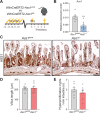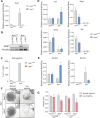Epithelial argininosuccinate synthetase is dispensable for intestinal regeneration and tumorigenesis
- PMID: 34599156
- PMCID: PMC8486827
- DOI: 10.1038/s41419-021-04173-x
Epithelial argininosuccinate synthetase is dispensable for intestinal regeneration and tumorigenesis
Abstract
The epithelial signaling pathways involved in damage and regeneration, and neoplastic transformation are known to be similar. We noted upregulation of argininosuccinate synthetase (ASS1) in hyperproliferative intestinal epithelium. Since ASS1 leads to de novo synthesis of arginine, an important amino acid for the growth of intestinal epithelial cells, its upregulation can contribute to epithelial proliferation necessary to be sustained during oncogenic transformation and regeneration. Here we investigated the function of ASS1 in the gut epithelium during tissue regeneration and tumorigenesis, using intestinal epithelial conditional Ass1 knockout mice and organoids, and tissue specimens from colorectal cancer patients. We demonstrate that ASS1 is strongly expressed in the regenerating and Apc-mutated intestinal epithelium. Furthermore, we observe an arrest in amino acid flux of the urea cycle, which leads to an accumulation of intracellular arginine. However, loss of epithelial Ass1 does not lead to a reduction in proliferation or increase in apoptosis in vivo, also in mice fed an arginine-free diet. Epithelial loss of Ass1 seems to be compensated by altered arginine metabolism in other cell types and the liver.
© 2021. The Author(s).
Conflict of interest statement
The authors declare no competing interests.
Figures








References
Publication types
MeSH terms
Substances
Grants and funding
LinkOut - more resources
Full Text Sources
Molecular Biology Databases
Miscellaneous

